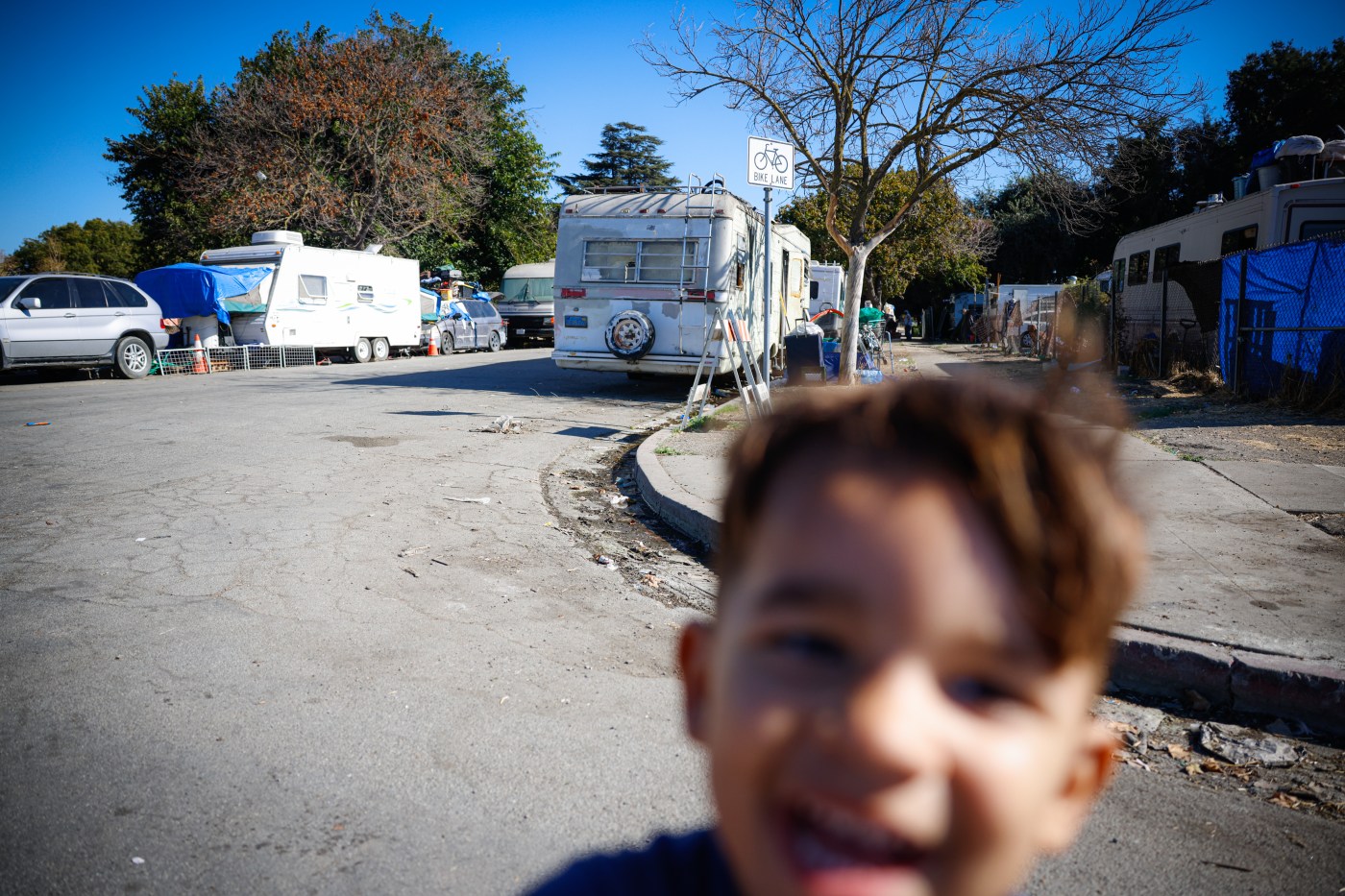
Families with infants and toddlers live in one of San Jose’s most dangerous encampments
A red Radio Flyer wagon. A tiny pink chair adorned with the face of a Disney princess. A jumbo pack of Huggies diapers.
These are a few of the items spread across one of San Jose’s most dangerous homeless encampments.
It’s evidence that children, including infants and toddlers, live or spend time with their families in trailers and RVs at the longtime encampment at Columbus Park, just south of San Jose Mineta International Airport. Some are migrants who recently fled gang violence in Central and South America.
Children are not uncommon at homeless camps across the Bay Area and California, and this news organization counted at least eight at the Columbus Park site. According to the latest statewide tally in 2023, an estimated 3,500 children under the age of 18 went to sleep each night without a roof over their heads, a 40% spike from a year earlier.
In August, the Bay Area News Group wrote about a family with a 7-year-old boy while they were living at a secluded encampment by the railroad tracks in South San Jose.
But the Columbus Park camp, a collection of dozens of lived-in trailers and RVs, has a reputation for being especially unsafe. Homeless residents say drug use is widespread and gunshots sometimes ring out at night. In February, authorities charged two people in connection with a fatal stabbing at the camp.
Citing privacy concerns, local homeless service providers declined to share how many children they’ve counted at the encampment. City officials also declined to provide a tally.
Angelika Cordova lives in a dilapidated trailer at the park with her 2-year-old son, Jeremiah. Cordova, 30, said she worries about preventing the bouncy toddler, who teeters around the camp in a pair of purple Nikes, from picking up syringes or being exposed to fentanyl, as well as keeping him away from aggressive dogs that roam the camp.
Jeremiah, 2, stands on a RV in an encampment in San Jose, Calif., on Tuesday, Oct. 8, 2024. (Shae Hammond/Bay Area News Group)
Last month, Cordova and her son returned to the encampment by the Guadalupe River after being removed from a hotel shelter for families near downtown San Jose.
Jeremiah now asks when they can return. “The other day, he was like, ‘Go home?’” Cordova said.
Some of the children living at Columbus Park accompanied families escaping violence and economic upheaval rippling across some Latin American countries, part of a recent wave of migrants that cities across the Bay Area and the country have struggled to shelter.
For most of the past year, Jose Mejia, his wife, Saira Monge, and two sons and a daughter — ages 8, 10 and 16 — have lived in a sun-faded RV at the edge of the encampment. The couple, who work for a janitorial contractor at the Tesla factory in Fremont, said they came to the U.S. from Honduras about three years ago after family members were targeted in their home country.
Jose Mejia makes adjustments to install a new fridge in their RV dwelling where his wife and three children used to live at the Columbus Park homeless encampment in San Jose, Calif., on Saturday, Oct. 26, 2024. The Mejia Family got help staying in a hotel for 90 days, he says. He also maintains the RV because they cannot cook in the hotel’s room. (Ray Chavez/Bay Area News Group)
“They killed my father,” Monge, 27, said in Spanish.
San Jose recently moved the family to a hotel room, but they still regularly return to the RV, where they keep a few small vegetable plants in plastic pots and rent a blue portable restroom secured with a yellow padlock. Mejia said the family may need to move back into the camper once the 90-day hotel program is up, explaining they can’t afford to scrape together the thousands of dollars needed for a security deposit on a market-rate apartment.
In one of the dozen campers parked beside a nearby trash-covered baseball diamond, Angie Useche, 22, lives with her 7-year-old son and 3-month-old daughter. Her mother, 2-year-old niece and 15-year-old nephew also live at the encampment. Useche said the family fled cartel violence in Colombia, arriving in the U.S. about five months ago.
On a recent afternoon at the camp, Useche’s son, Milan, dressed in a blue Spiderman T-shirt and American flag shorts, chased after a young girl darting between empty propane tanks, discarded car parts and humming gas-powered generators hooked up to residents’ RVs.
Useche’s mother, Sandra Barrios, said her husband found a job in the automotive industry but that she still hasn’t found work. Asked whether outreach workers have offered the family any help, she shook her head. “No one ever comes by here,” she replied in Spanish.
Sofia, 2, sits on a box spring next to her grandmother Sandra Barrios, as they look on from their RV dwelling at the Columbus Park homeless encampment in San Jose, Calif., on Saturday, Oct. 26, 2024. (Ray Chavez/Bay Area News Group)
City officials, while declining to discuss the families’ individual circumstances, said outreach teams are working with most families at Columbus Park and visit the encampment several times a week. The ultimate goal is to help those “who are unsheltered into a form of shelter, into a form of housing,” said San Jose Housing Director Erik Soliván.
The city has also cleared out parts of the camp several times in recent years, citing safety concerns and agreements with the Federal Aviation Administration because of the proximity to the airport. The most recent sweep came in September, a few months after a landmark U.S. Supreme Court ruling granted cities expanded authority to disband encampments.
What, then, is preventing officials from moving every family out of Columbus Park?
“The harsh reality here is that we have more unhoused families than we have (shelter and housing) units available,” said Beatriz Ramos, vice president of emergency housing at HomeFirst, a Milpitas-based nonprofit the city contracts to send outreach teams to Columbus Park.
Even as local officials and nonprofits have worked to add hundreds of family shelter beds in recent years, Santa Clara County counted 211 homeless children living without shelter in 2023, up from 112 the year before, but well below the 664 identified in 2017.
When beds do become available, Ramos said, it can still be difficult to persuade families to accept help out of fear they could lose custody of their children. “Being homeless is not a reason to remove children,” she said.
Footwear from seven family members rests on the wheels of their RV dwelling at the Columbus Park homeless encampment in San Jose, Calif., on Saturday, Oct. 26, 2024. (Ray Chavez/Bay Area News Group)
Despite the dangers at Columbus Park, Cordova, who receives county assistance payments to help support her son, said she chooses to stay there to be near friends who live at the encampment.
“I don’t feel like I’m alone with just my kid, you know?” she said. “That makes it a little more comfortable.”
Cordova said she spent much of her childhood in Santa Clara County’s foster care system before bouncing between living situations as an adult. After falling into depression, she began living on the street. When Jeremiah was born, Cordova was enrolled in a housing program in Gilroy, where she stayed with the boy’s father. But once he moved out, Cordova said she could no longer afford the rent and had to stop working to care for Jeremiah full-time.
Related Articles
After seeking homeless spending cuts, Newsom announces $170 million to bring Bay Area residents off the street
Candidates looking to fill open Berkeley council seats weigh in on encampment policy
San Jose Rotary unveils mobile medical clinic to serve vulnerable populations
Groups behind Berkeley protest encampments call for the movement to spread across the state
Walters: How much to end homelessness in California? Try $100 billion
Plans to find other housing fell through. So she bought a trailer from a friend and moved to Columbus Park. About a year later, a street outreach team helped get her into the hotel shelter in San Jose. Cordova said she and Jeremiah stayed at the hotel for around six months before she received a letter from the site’s nonprofit operator, Santa Clara-based LifeMoves, stating she was expelled for keeping cats and refusing to allow site staff to inspect her room for health and safety issues. Cordova claims she was forced out for threatening to file a complaint against site staff for harassment, including entering her room without permission.
LifeMoves declined to comment on Cordova’s case. However, the nonprofit said in a statement that “discharging a client back to homelessness is a last resort, and our staff work diligently to avoid such measures.”
Cordova is now thinking of moving to Oregon, where her siblings live. Apartments are less expensive up north, and she hopes it would be easier to find a retail job and enroll in school.
“As a parent, I want to do way more for him,” she said. “I don’t want to be living outside in a trailer. It’s not the best thing.”
Ray Chavez and Kristin Bender contributed reporting.
Milan, 7, plays with toy money outside his family’s RV dwelling at the Columbus Park homeless encampment in San Jose, Calif., on Saturday, Oct. 26, 2024. (Ray Chavez/Bay Area News Group)
A man with a knife in his belt rides along the Columbus Park homeless encampment in San Jose, Calif., on Saturday, Oct. 26, 2024. (Ray Chavez/Bay Area News Group)
An unhoused person stands outside her dwelling next to a basketball court at the Columbus Park homeless encampment in San Jose, Calif., on Saturday, Oct. 26, 2024. (Ray Chavez/Bay Area News Group)
Sandra Barrios holds her granddaughter Sofia, 2, as they look on from the door of their RV dwelling at the Columbus Park homeless encampment in San Jose, Calif., on Saturday, Oct. 26, 2024. (Ray Chavez/Bay Area News Group)


